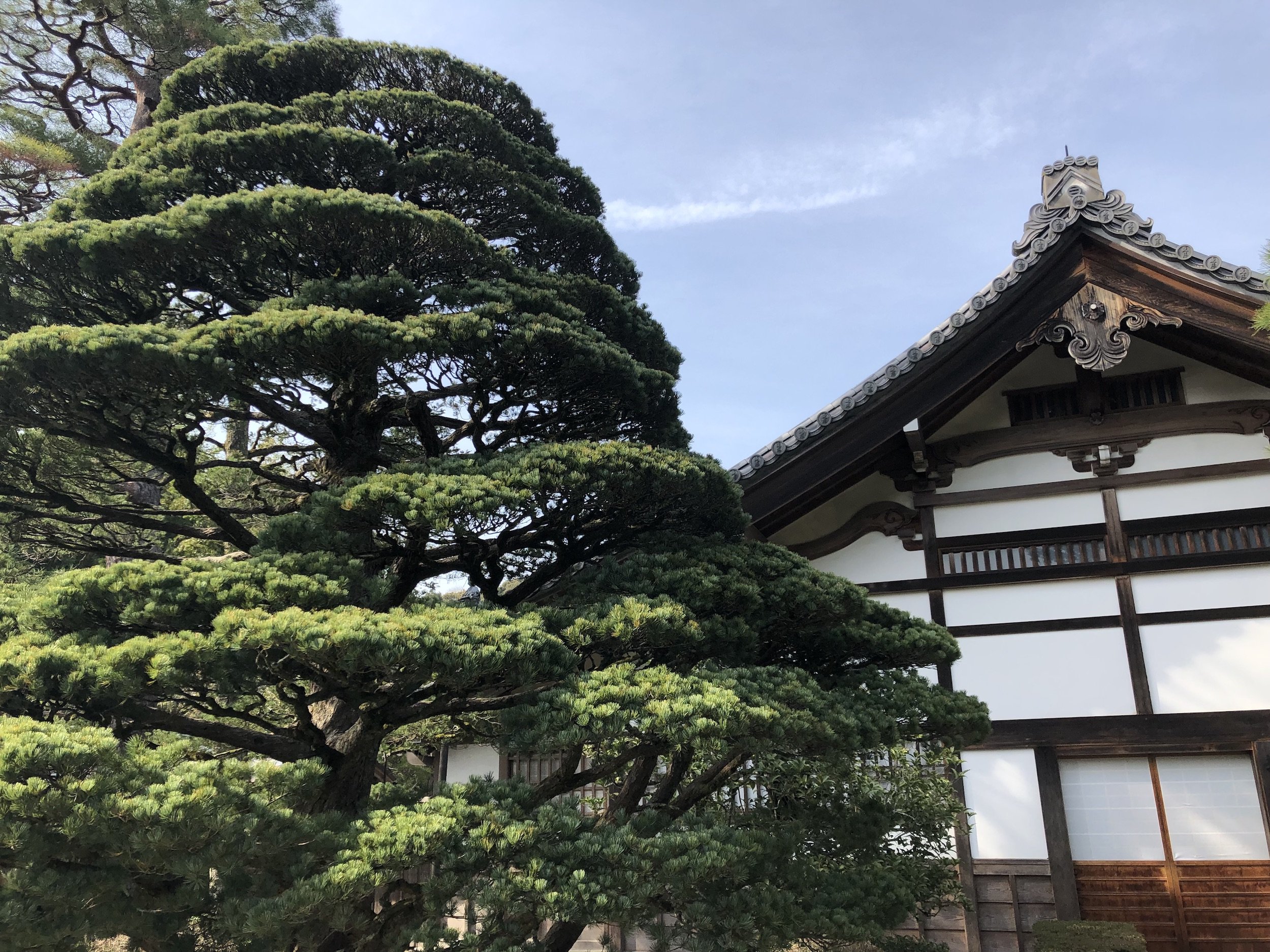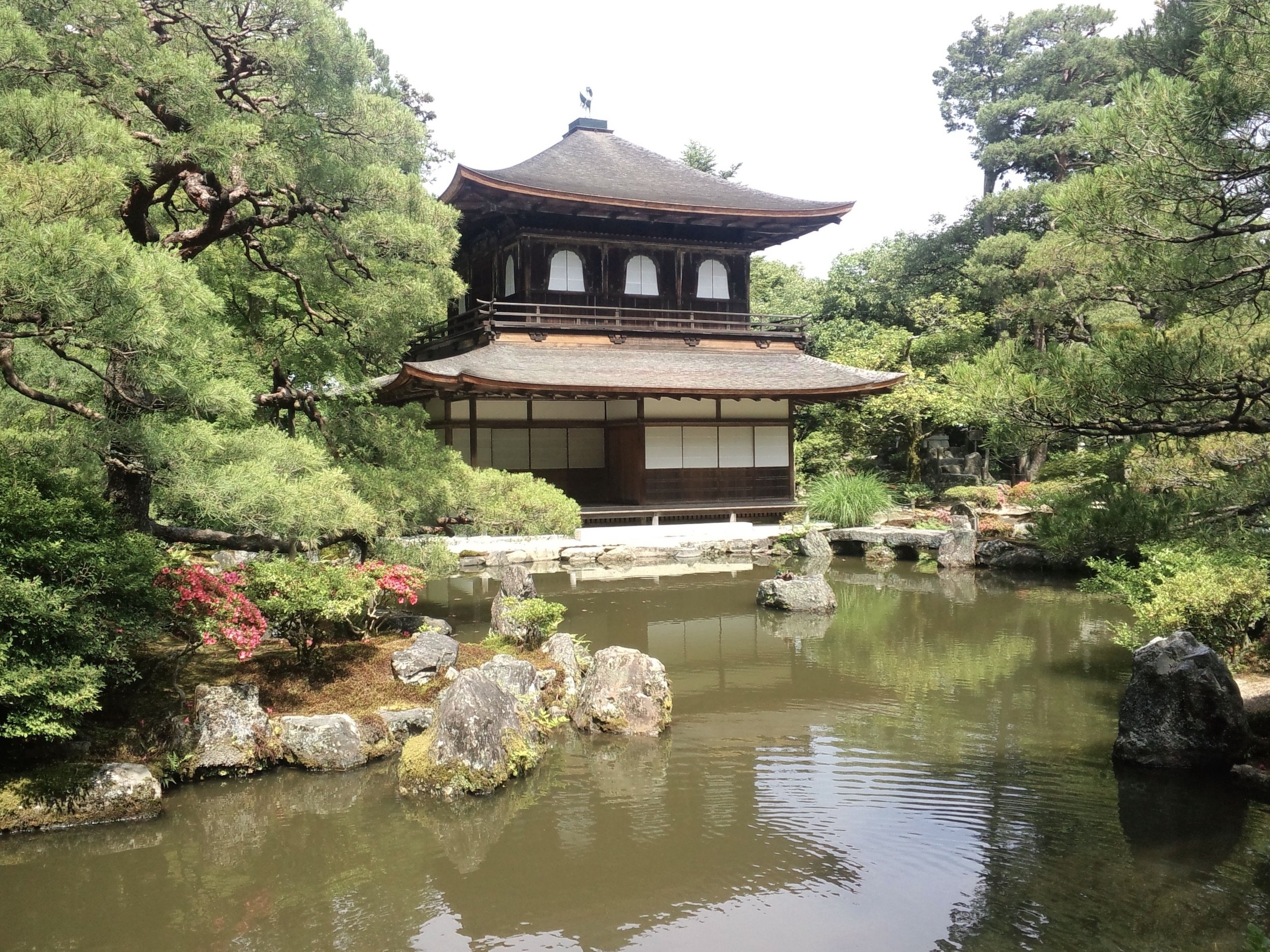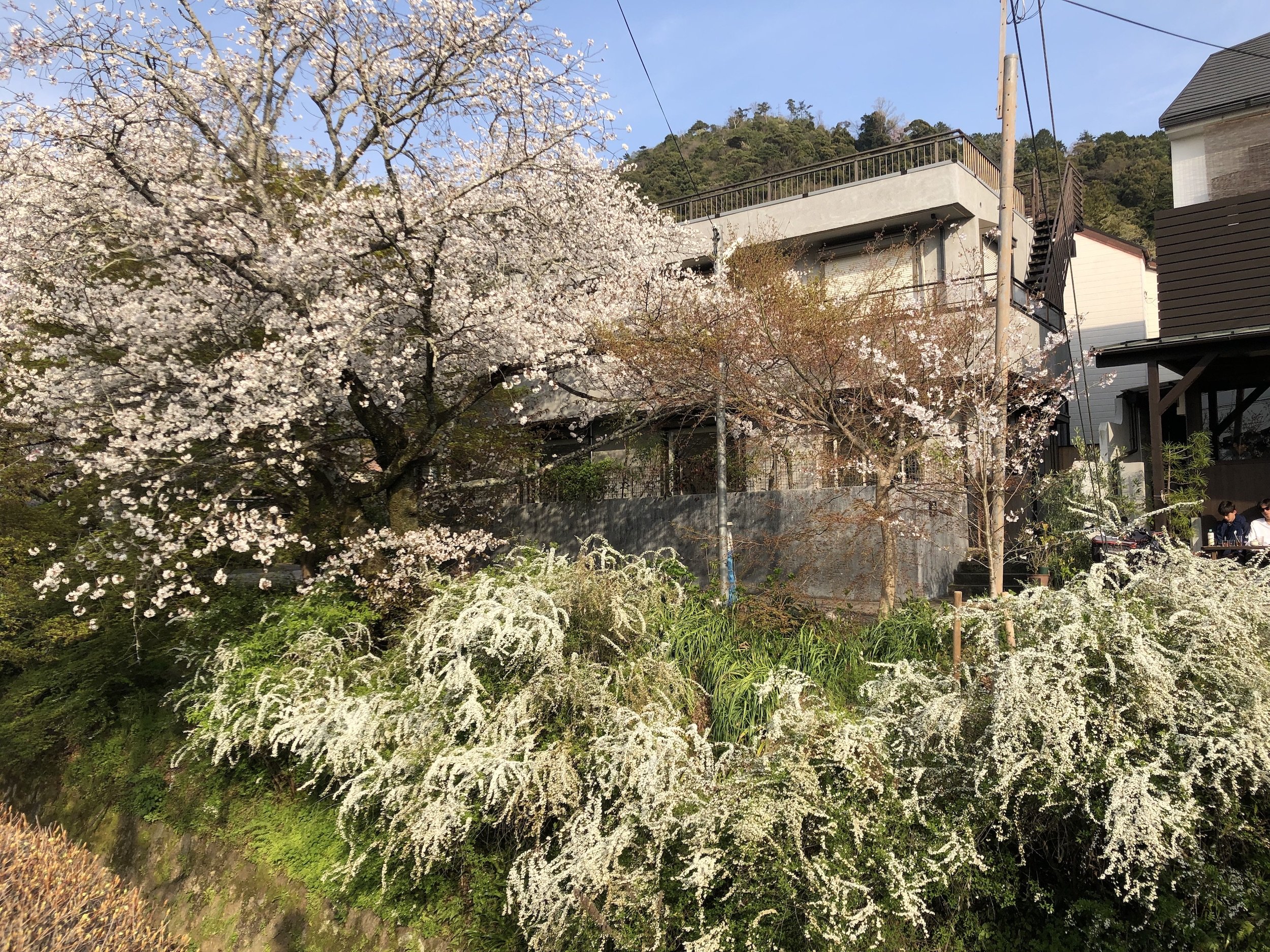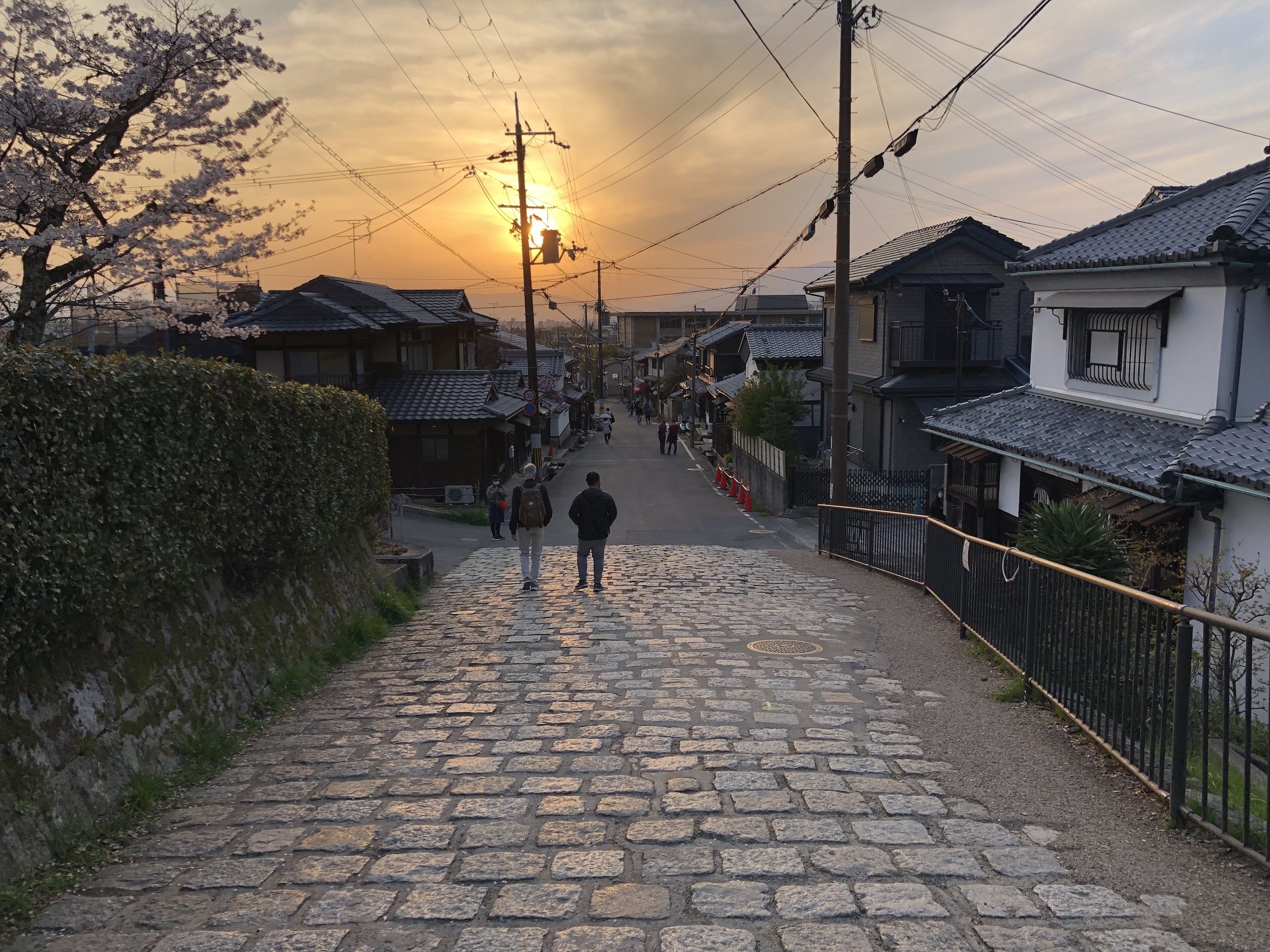In my last post, covering Nanzenji Temple and the Keage Incline, I neglected to mention that the temple is where Tetsugaku no michi, the Philosopher’s Path, terminates in Kyoto. This walking course runs about a mile and a quarter along a steep canal with hundreds of sakura trees hanging over it, so it’s a popular stretch for cherry blossom viewing when it comes alive with flowers in late March and early April. The course begins along the approach to Ginkaku-ji, another famous temple in Kyoto, so you could visit it first and then follow the Philosopher’s Path down to Nanzen-ji.
The Temple of the Silver Pavilion (A.K.A. Jisho-ji)
As a temple name, Ginkaku-ji is something of a misnomer for two reasons. First of all, it’s a colloquial name. The real name of this Zen Buddhist temple and UNESCO World Heritage site is Jisho-ji. Second of all, Ginkaku-ji means “Temple of the Silver Pavilion.” However, unlike its cousin, Kinkaku-ji — which completely lives up to its name as the Temple of the Golden Pavilion — Ginkaku-ji famously isn’t silver.
That doesn’t make it any less beautiful; it just means you should temper your expectations if you’ve seen the Golden Pavilion already and were hoping for a silver sequel at Ginkaku-ji. The temple began construction in 1482 as a retirement villa for the shogun Ashikaga Yoshimasa, who was inspired by the design of his grandfather’s villa at Kinkaku-ji.
When you’re walking up on Ginkaku-ji, you can see the giant scar of the kanji character for Daimonji on the mountain behind it, similar to the one on the east mountain near Kinkaku-ji. This is from the annual bonfires of the Gozan no Okurubi festival, which serves as the big finish to the Obon season in Kyoto every August 16th.
Inside the temple, the pavilion that gives it its name, Ginkaku (officially known as Kannonden), sits back across a pond, though you can see the side of it up close when you enter and exit. Some other features of interest in the garden are the Kogetsudai (“Moon-Viewing Mound”) and the Ginshadan (“Sea of Silver Sand.”) The longer of the two possible walking routes also leads up to a lookout point where you can get an elevated view of the temple compound.
Reminders of the Lost Kyoto at Ginkaku-ji
A combination of cherry blossom season and a tourist base that’s greatly increased, anyway, made Ginkaku-ji much more crowded in the spring of 2023 than when I first visited it in the summer of 2013. This was evident right when we first walked up and saw a long line of people waiting along the fence to buy their 500-yen tickets into the temple.
The line continued up to the lookout point, and as we were walking down from there, I had a British lady over my shoulder the whole time telling some story about how she smuggled Johnnie Walker Black through customs when she flew into Japan. That kind of ruined the image of the peaceful Zen garden a little. It made me wistful for the lost Kyoto, the quieter place of unspoiled beauty that you could see ten years ago before it became such an international tourist hotspot.
That night, I revisited Fushimi Inari Shrine, since it was only two stations away from where we were staying and this was a rare chance to see its well-known tunnel of torii gates without so many people around. As I was waiting to come back to the hotel, where Azusa was resting up, I overheard snippets of another tourist couple’s conversation, where one of them said, “Shall I post the geisha pictures?” and, “Ooh, look what Insta did.”
I realize that by tweeting and blogging like this about the temples and shrines of Kyoto, I’m encouraging more tourism to them, and it leaves me in no position to judge anyone and their liquor smuggling or Instagramming of geisha pics. But I guess the point of this sidebar is, just be respectful when you’re in Kyoto and mindful of the people (and place) around you.
Cherry Blossoms Along Tetsugaku no Michi
As mentioned, Tetsugaku no michi, the Philosopher’s Path, leads away from Ginkaku-ji and is a prime spot for cherry blossom viewing in the springtime. The path takes its name from philosopher Kitaro Nishida, who used to stroll along here and meditate.
We have a similar canal lined with cherry trees near our apartment in Tokyo, but I found the Philosopher’s Path much more visually resplendent, maybe because it’s so narrow and you’re walking right under the trees most of the time, with the blossoms blooming all around you and the water carrying ducks and fallen petals gently downstream.
As we got further away from the temple, the only immediate way station for food I recall seeing was this place with a patio called The Diner, which serves (and indeed, Instagrams) Philly cheesesteaks, something of a rarity in Japan for obvious reasons. The fact that there’s this restaurant along the Philosopher’s Path catering to travelers with American cuisine says it all.
The path does wind through residential neighborhoods, and along the way, Azusa noticed an old Japanese man standing in the street with people passing him by, many of them foreigners like me. He looked a little dazed to me, but she had him pegged as one of the neighborhood residents and compared him to a native Martian, seeing colonizers from another planet arrive.
She was right about him living there, as we soon saw him heading back into his house and closing the gate behind him. Maybe I’m just projecting onto that old man, but I imagine that whatever sense of wistfulness I felt about the lost Kyoto, he must have been feeling tenfold.
The Ginkaku-ji To Nanzen-ji Walking Course
If you start early enough in the day, you should have more than enough daylight to do the whole Ginkaku-ji to Nanzen-ji walking course along the Philosopher’s Path. The only reason we didn’t do both temples in one day is that we arrived in Kyoto in the afternoon. By the time we checked into our hotel, took the long #5 bus ride across town, visited Ginkaku-ji, and got to the end of the Philosopher’s Path, the sun was setting and it was past closing time for Nanjzen-ji.
From March to November, both temples close at 5 p.m., but the last entry to Nanzen-ji is at 4:40. And while the bus ride to Ginkaku-ji is supposed to take 35 to 40 minutes, it was more like 50 or 55 minutes with traffic. So, for the benefit of fellow travelers planning an itinerary, that’s basically an hour from door to door (or station to temple gate, as the case may be).
























